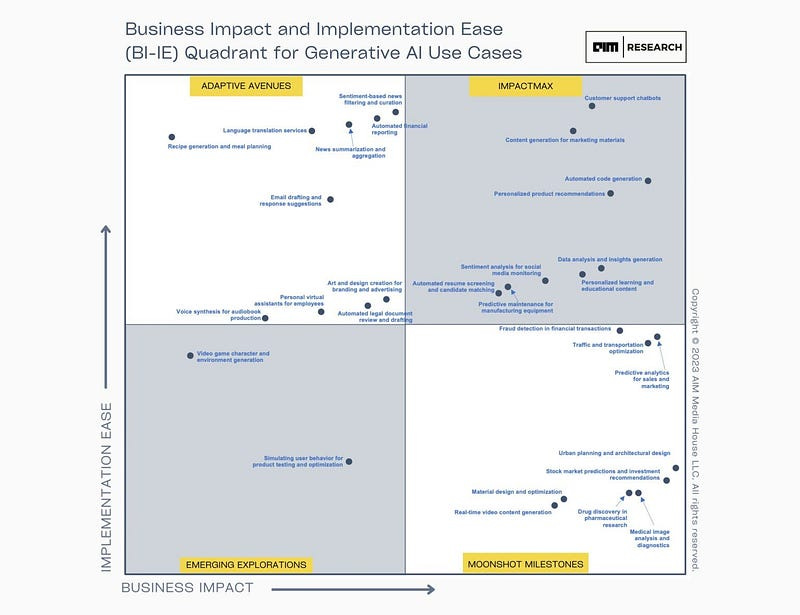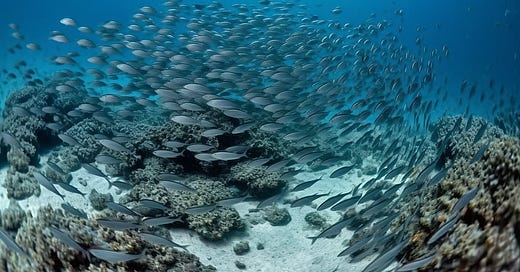Generative AI Redefines the Content Bottom
Across the world every week, tens of millions of people are using text, image, presentation, voice, design, and soon, video generators to…
Across the world every week, tens of millions of people are using text, image, presentation, voice, design, and soon, video generators to create and share content. The result is a general increase in content quality, effectively elevating and establishing a new bottom for marketers and content creators.
This content quality baseline is the result of AI algorithms calculating what is the highest probability for the correct execution of a prompt, the law of averages at work. The new bottom is functional and adequate, but at the same time mundane and formulaic.
“What is right is not always popular and what is popular is not always right.” Albert Einstein
This new bottom will be equally populated with popular content online, socially validated by users, rather than factually correct. In the worst cases, it is shamefully inaccurate thanks to AI hallucinations and human fact-checking fails.
The ability to create content that is at least functional at a significantly faster clip will definitely create job impacts, in my opinion. Let’s take a deeper look.
How Will Generative Impactive the Creative Workforce?

Six months into the ChatGPT revolution, I believe generative text writing will replace a fair amount of human writing, but in most cases, it will augment it. Generative AI adds bandwidth allowing brands to create a lot of content they wanted but for whatever reason — usually resources — could not.
That being said, generative AI will replace low performers. Most writers that survive will become facilitators (or “prompt engineers”) and editors in this model. Those who are not great writers already, and cannot or will not adapt generative AI will fall out of the workforce.
This is not a new trend. It’s akin to the 1980s when Microsoft Excel came out. Imagine an accountant who refuses to learn how to use Excel, or later in the evolution of accounting software, Quickbooks, or Xero. It would be hard for such an accountant to remain employed.
The visual side of the equation is a little more murky to me. I still see a need for graphic design, photography, and videography. However, like writing, some or a lot of the work will be completed by AI, depending on the need.
Photographers may capture original images, and then guide the editing process using AI tools to retouch. Once original images are captured, AI will likely be used to replicate the subject matter. A similar concept-to-finish-to-iteration pattern can be seen in other forms of visual creativity, including graphic design and video.
This content will rise to a level of usefulness, in many cases dazzling. But in the end, it will just be a higher average, a new bottom. And that bottom is literally the highest probability of success.
Rise the Outlier — The Uber Creative
The new bottom will also catalyze a market for brilliant human creativity. Since, all generative AI tools simply create the highest probability result based on their training data including writing, photographic, and art styles— a result of the source content, from text to imagery.
The very definition of creativity is “having the power to bring something new into being, as a creature, or to evolve something original from one’s own thought or imagination, as a work of art or invention.” Averaging old original ideas is a derivative work, but wholly original.
AI’s inability to truly create uniqueness — again it just works off of probability — provides an opportunity for those that can. Exceptional creativity will stand out like a beacon in the night.
“There is no doubt that creativity is the most important human resource of all. Without creativity, there would be no progress, and we would be forever repeating the same patterns.” — Edward De Bono
In a world of probability-based content, statisticians and data scientists would call these outliers. Perhaps those of us in the business would call them uber creatives, the Bilal Baigs and Matthew McConaugheys of the world, people who create things that are undeniably distinct.
The market for uber creativity will rise to the top, standing out like the proverbial red thread in a sea of grey. AI’s role will be to take that creative concept and execute it in different media forms but under the meticulous guidance of the uber-creative.
Some Examples Illustrating the Bottom
Let’s define the bottom as the highest probability of success based on training data — human and increasingly synthetic (AI-generated) content sourced to the AI. This is particularly true of text generators, but also image generators which create based on probability.
ChatGPT is leading the way with its 1 billion users to date! How many of them are using it to query for information versus prompting it to create content? Still, incredible and impressive adoption. ChatGPT has become an overnight Internet utility.
I use ChatGPT frequently in my work, using it to create foundational elements and summaries of content. Once or twice a week, it produces a piece of content that suffices. It meets the desired need, illustrates the thesis, is factual (yes, I check), and so it gets published.
But is it good? It’s adequate. I wouldn’t want to read it unless I needed to learn about that particular topic.
On a different project, I am creating a logo using various generative art tools. The logos are functional and good enough. I am close to a finished product that success seems likely. The logo will be deployed.
But is it exceptional? Let’s put it this way, I cannot imagine the logo as a stand-alone image for a shirt or a hat that people would be excited to wear. If the project takes off, a designer will need to evolve the concept, but the returns need to justify the budget.
And so it goes, all across the Internet more and more of this type of content is deployed. Welcome to the era of uninspiring and inauthentic, but utilitarian generative AI content. If done right it fulfills the need, but little more than that.
Stay up to date with the latest news and updates in the creative AI space — follow the Generative AI publication.






